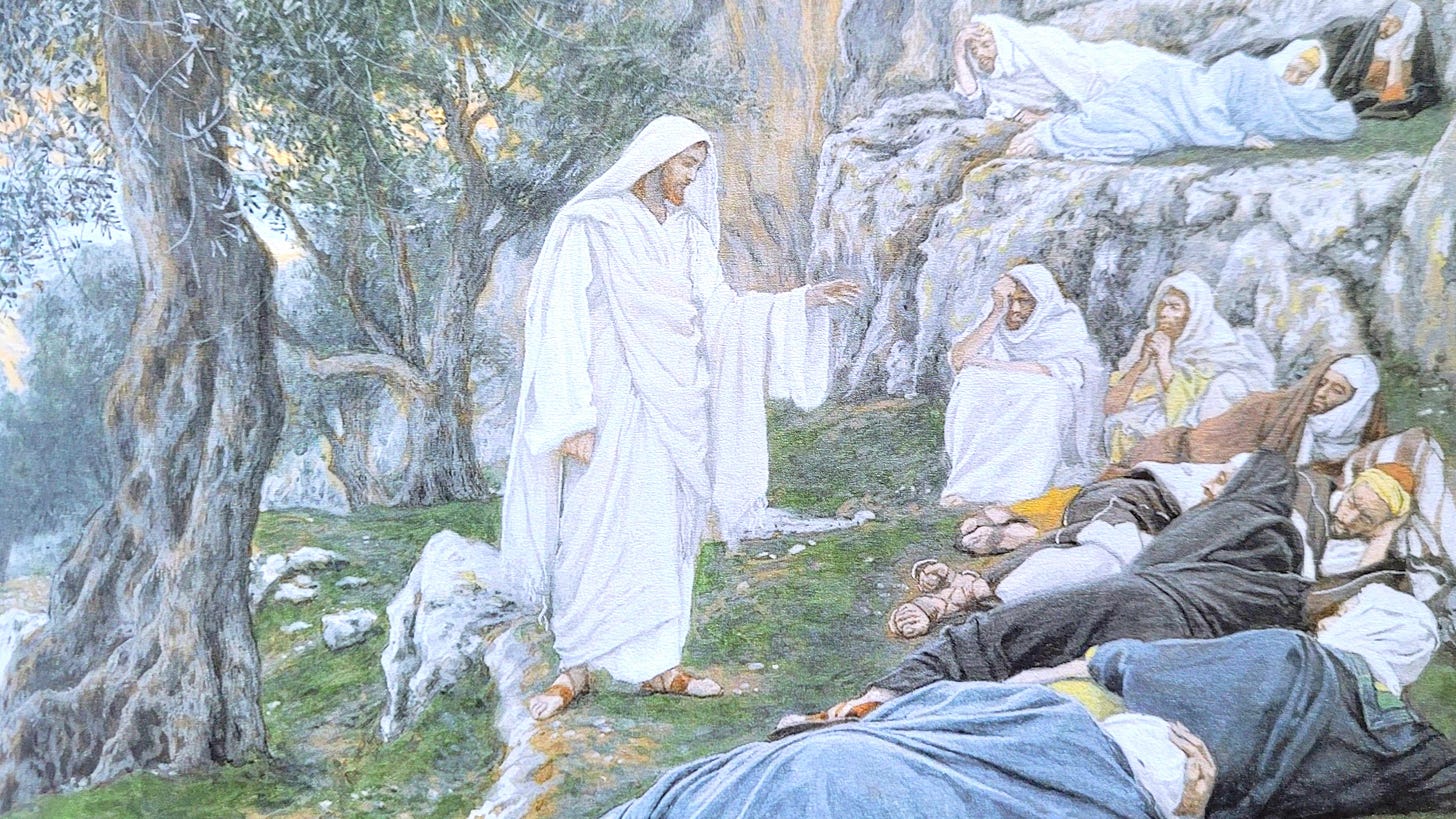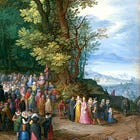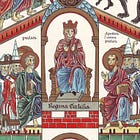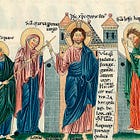Why did Christ and his Apostles withdraw before feeding the five thousand?
And how did Herod’s threats prepare for the first teaching about the Eucharist?

How did Herod’s threats prepare for the first teaching about the Eucharist?
Editor’s Notes
In this piece, Fr. Coleridge tells us…
How Christ withdrew to solitude for rest, retreat, and the secret preparation of a miracle.
That this providential gathering reveals the Church’s rhythm of labour, repose, and divine nourishment.
Why even apparent accidents in the Gospel are divine arrangements for deeper mysteries.
He shows us that the rest of apostles and the hunger of the crowd were both drawn into the mystery of the Blessed Sacrament.
Some Context
This episode—the only miracle besides the Resurrection—is sung on the Fourth Sunday of Lent. Its reading at this time highlights the link between the Holy Eucharist and the Passion of Christ, which the Church is preparing to commemorate.
It takes place shortly after the death of St John the Baptist, and during the Galilean ministry, when the Apostles return from their first mission and Herod’s hostility towards Christ becomes more open.
Christ draws the Apostles into solitude after their labours, and then, with deliberate forethought, multiplies loaves to prefigure the Holy Eucharist. The miracle establishes the role of the Apostles in distributing divine nourishment, reveals Christ’s hidden intentions in every act of mercy, and begins to unfold the Church’s theology of priesthood, sacrifice, and communion.
Feeding the Five Thousand
The Training of the Apostles, Part IV, Chapter VII
St. Matt. xiv. 13-21; St. Mark vi. 30-34; St. Luke ix. 10-17; St. John vi. 1-13.
Story of the Gospels, § 72
Burns and Oates, London, 1885
Headings and some line breaks added.
Sung on the Fourth Sunday of Lent
Part I: Why did Christ and his Apostles withdraw before feeding the five thousand?
Part II: Why did Christ wait until evening to feed the multitude?
Part III: What does the multiplication of loaves teach about the Church and the Apostles?
Part IV: Was Christ thinking of the Holy Eucharist when he multiplied the loaves?
The Apostles returning to our Lord
The Evangelists tell us that, on the reception by our Lord of the intelligence of the disposition of the crafty and unscrupulous Tetrarch towards Him, He retired by means of a boat into a desert place apart.
At the same time they place the return to our Lord of the Apostles, who had been scattered in pairs over the country for the purpose of their first missionary tour. It is not impossible that our Lord may have kept them always in close correspondence with Himself, even while absent from His side, and that thus it may have been easy for them to be summoned in a few days, or less, to the spot at which He was, probably near one end of the Lake.
They would naturally be full of their mission, especially if, as seems likely from something afterwards mentioned concerning this tour, they had had great success and had been well received and cared for by the people among whom they went. It is not even certain that they had heard of the words of Herod to his servants, which contained so much to alarm the friends of our Lord.
The first thing, therefore, would be for them to give a report of their proceedings and of the issue of their mission in various places. This was the foundation of an invariable rule in the Church. After this our Lord invited them to take some rest, not so much perhaps for their bodies as for their souls. For active missionary work is always liable to steal away something from recollection and peace of mind, and it was to be an example which was to be handed on from the Life of our Lord Himself, that all those employed on such labours for souls should be careful to refresh their own spirits by short intervals of rest, prayer, and solitude.
The desert of Bethsaida
‘Which when Jesus had heard, He retired from thence in a boat to a desert place apart. And the Apostles coming together unto Jesus, related to Him all things that they had done and taught. And He said to them, Come apart into a desert place, and rest a little. For there were many coming and going, and they had not so much as time to eat. And going up into a ship they went into a desert place apart.’
St. Luke says the place belonged to, or was near, Bethsaida, and St. John says that to reach it our Lord went over the Sea of Galilee. The name Bethsaida applies to more than one place, and thus the spot is not fixed for us with any certainty, but it is of little moment thus to fix the places mentioned in the Gospels. Thus our Lord provided at once for three great objects which He had, as we may think, in His Heart at this time.
One of these was to keep Himself still out of the sight of the world, and especially of His enemies, to the number of whom must now be added the Tetrarch Herod.
Another object was to draw the Apostles away from the active life of too much pressure on their time, which was the inevitable result of their success and industry in their preaching.
And a third was to provide for the presence of a large multitude in a lonely place, where there could be no interruption, for the purpose of feeding them with the few loaves which He intended to multiply for their sustenance, and thus to lay the foundation by this new kind of miracle, and by the discourse on the subject which was to follow, for the introduction of the doctrine relating to the marvellous invention of His love, of which no one but Himself had yet conceived the thought, in the Blessed Sacrament and Holy Communion.
Arrangement of the occasion
All was done with the utmost simplicity and quiet. It was perfectly natural that He should go into a desert place after the intelligence which He had received. It was equally natural that He should urge on the Apostles the necessity of retirement for them, and also that the people about Capharnaum, who had probably not seen Him for several months or weeks, should desire to get to Him as soon as they found out where He was to be reached. Thus, in the simplest way, the occasion and the actors, so to say, in this great miracle, were furnished, the spot was chosen, and the crowds were ready, without any provision for themselves, and all had come about as it were by accident.
So it was all through the Public Life of our Lord. He arranged the circumstances which led, as it were spontaneously, to His greatest miracles and teachings, and all seemed to come about of itself. There would have been no occasion for the miracle if He had been teaching the multitude on the seashore near Capharnaum. But He would not have retired into the desert merely for the purpose of inducing them to follow Him. So He took the occasion of the need of the Apostles for rest and solitude, and in that way drew after Him the crowds whose presence was necessary for the significant miracle He was about to work, a miracle which contained in itself the prophecy and the promise of a boon far more marvellous, far more lasting, far more beneficial, than that simple multiplication of the loaves in which it consisted.
The multitude coming
‘And the multitudes having heard of it followed Him on foot, out of the cities. And they saw them going away, and many knew, and they ran following thither on foot from all the cities, and were there before them. And a great multitude followed Him, because they saw the miracles which He did on them that were diseased. Jesus therefore went up into a mountain, and there He sat with His disciples.’
All this points to some well-known and not distant spot. The position on the mountain enabled them to see from a distance the people who were coming to them from all parts around.
A beautiful sight for the Sacred Heart of our Lord! for these multitudes represented to Him the far more countless crowds who were to be fed by Him in the Church in all ages, not on loaves and fishes, or any food that would support the body only for a short time, but on the saving banquet of His own Precious Body and Blood, the food of the elect, the partaking of which was to be the source to them of eternal life both of the body and of the soul.
End of Part I. Having drawn the Apostles into retreat and drawn the multitudes into the wilderness, our Lord silently prepared for a work of deeper meaning. Now, as the crowds assemble and the setting takes shape, He begins to show that their hunger is no accident, but part of a divine plan that will reveal his power and prefigure his Sacrament.
Feeding the Five Thousand
Part I: Why did Christ and his Apostles withdraw before feeding the five thousand?
Part II: Why did Christ wait until evening to feed the multitude?
Part III: What does the multiplication of loaves teach about the Church and the Apostles?
Part IV: Was Christ thinking of the Holy Eucharist when he multiplied the loaves?
Read Next:
Here’s why you should subscribe to The Father Coleridge Reader and share with others:
Fr Coleridge provides solid explanations of the entirety of the Gospel
His work is full of doctrine and piety, and is highly credible
He gives a clear trajectory of the life of Christ, its drama and all its stages—increasing our appreciation and admiration for the God-Man.
If more Catholics knew about works like Coleridge’s, then other works based on sentimentality and dubious private revelations would be much less attractive.
But sourcing and curating the texts, cleaning up scans, and editing them for online reading is a labour of love, and takes a lot of time.
Will you lend us a hand and hit subscribe?
Follow our projects on Twitter, YouTube and Telegram:






